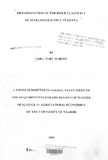| dc.description.abstract | The production of sunflower and other oil crops in Kenya has been low and declining
over the years. In order to feed its population, Kenya has over the years been importing
vegetable oils and fats in form of crude palm oil and thus utilising its limited reserves of
foreign exchange, which could otherwise be used to finance other development projects.
This trend is expected to continue as domestic consumption still far outweighs local
production. For instance, the consumption of vegetable oils and fats in Kenya is currently
estimated to be over 200,000 tonnes per annum while domestic production is only about
20,000 tonnes. The difference has to be imported. The present study aimed at establishing
the effects of various factors, especially price changes, on the production of oil crops with
particular reference to sunflower. The study was prompted by the present Government
policy objective of saving foreign exchange through increased domestic production of the
major crops, especially oil crops, as documented in the current National Development Plan
(1994-96).
The double logarithmic version of the Nerlovian Partial Adjustment Model was used
to estimate the supply responsiveness of sunflower farmers in the major producing districts,
namely Meru, Bungoma and Trans-Nzoia districts. The data set used in the analysis range
from the years 1970 to 1992. The results revealed that sunflower fanners responded
positively to price changes in Meru District but negatively in Bungoma and Trans-Nzoia
districts. The first hypothesis, which assumed that sunflower farmers respond positively to
price changes, was therefore accepted for Meru District but rejected for Bungoma and
Trans-Nzoia districts. The calculated short-run price elasticities of supply range from a
value of -0.06 to 0.74. The second hypothesis was tested by means of the Chow test and
revealed that the degree of supply responsiveness of sunflower farmers varies from one
district to the other. In general, the results of this study indicate that the supply
responsiveness of suntlower farmers in Kenya is diverse and not well defined.
The other factors included in the supply response model were also found to
significantly influence the hectarage put under sunflower in any given year. The major
factors in this case are the lagged price of the most competitive enterprise, the lagged yield of sunflower, the annual rainfall amounts and the lagged hectarage which reflects the
adjustment difficulties facing the farmers.
The results of this study reveal that the pricing policy could only be used to partly
achieve increased production of sunflower. This is because, the results of the first
hypothesis test reveal that price may not always playa positive role in achieving increased
production, especially in Bungoma and Trans-Nzoia districts where the price elasticity is
negative. However, the negative price elasticity of supply for Bungoma and Trans-Nzoia
districts is not necessarily an indication of the economic irrationality of the farmers. It is
probable that the price offered for sunflower seed is so low that farmers in those districts do
not consider it in their hectarage allotment decisions. Such a situation would require that
a substantial price increase within the framework of market liberalization is given so as to
enable the farmers to meet the costs of production. This would allow the setting of a
minimum producer price, beyond which the market forces are allowed to operate freely.
The inability of the pricing policy to achieve increased production of sunflower
requires that other non-pricing policy measures come into play. This is in agreement with
the current policy of market liberalization which emphasizes on the use of other policy
measures (other than price) to achieve increased production of sunflower. In this regard, it
was found important that the yields of sunflower should be improved through research and
that the farmers are assured of a ready market tor their seed by providing adequate and easiIy
accessible market outlets. This would help in eliminating some of the difficulties faced by
the farmers in adjusting fully to the equilibrium supply. | en |

